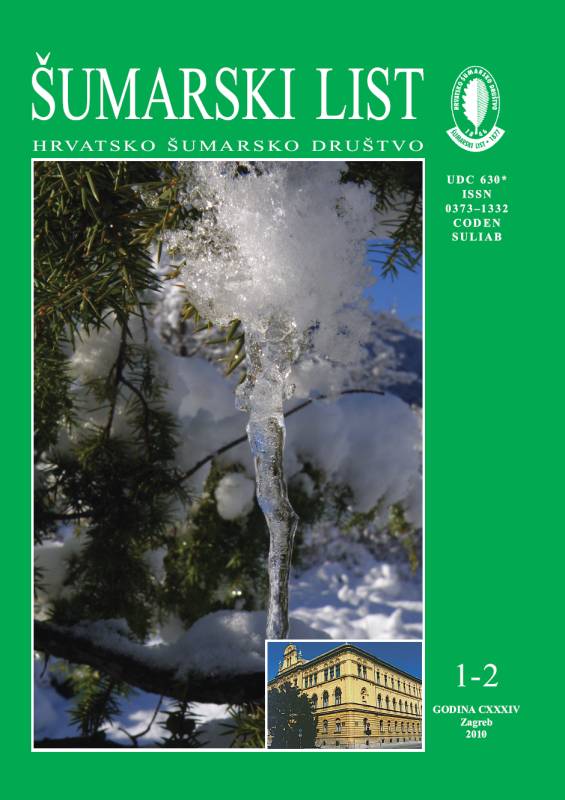
broj: 1-2/2010
pdf (9,0 MB) |
|
||||||||||||||
| RIJEČ GLAVNOGA UREDNIKA | ||
| Branimir Prpić | ||
| ON THE REGENERATION FINAL FELLING IN EVEN-AGED FORESTS pdf HR EN | 2 | |
| IZVORNI ZNANSTVENI ČLANCI | ||
| Idžojtić, M., M. Zebec, I. Poljak | UDK 630* 271 (001) | |
| Revitalisation of the Lisičine Arboretum pdf HR EN | 5 | |
| Trinajstić, Ivo | UDK 630* 164 + 188 (001) | |
| Chorological and Phytosociological Characteristics of Quercus Coccifera L. in Croatia pdf HR EN | 19 | |
| Pandža, Marija | UDK 630* 17 (001) | |
| The Flora of the Papuk Nature Park (Slavonia, Croatia) pdf HR EN | 25 | |
| Summary: The researches of the Papuk Natural Reserve flora were carried out from 2001 to 2005. The area was formally declared a natural reserve on April 23rd, 1999. It covers 335 km2 approximately. The borders of the Reserve are defined by the law on declaring the Papuk Natural Reserve (NN/99). The Reserve includes parts of the Papuk-Krndija mountains, lying in the east-west directed, along the Kutjevo-Velika-Kamenska-Vučjak-Zvečevo-Voćin-Slatinski Drenovac-Orahovica-Petrov vrh-Kutjevo line and belong to the so-called Slavonija mountains region. Within this region, Papuk and Krndija form one relief body. The floral diversity of Papuk is predetermined by its geological-lithological structure as well as its climatological characteristics. According to Köppen, the climate of the east Slavonija, from Daruvar to Ilok, belongs to cfwb”x” climate (temperately warm and rainy), without dry periods, precipitation evenly distributed throughout the year, the driest period being in winter (Seletković i Katušin 1992). The average year temperature for a 30 year period (1961–1990) measured by the climatological station of Požega, is 10.6 oC and year precipitation quantity is 782 mm. There are three vegetational zones: (re. Trinajstić 1995, 1998) firstly low-hills area (from 100 to 250 m) belonging to the durmast-oak forests zone; secondly, the mid-hills area (250 to 900 m) dominated by European beach forests and finally the mountainous area (above 900 m) with European beach and silver fir. These three zones include a range of associations, depending on particular conditions of their habitats (floods, lithological base structure etc.). The phytocenological researches of Papuk (Franjić 2002) resulted with 13 plant associations that form the major part of the vegetation of this area. Forests cover the majority of the Reserve. Apart from forest associations, there are other important habitats abundant in plant species, meadows, forest border-lines, swamp vegetation etc, even though they don’t cover large areas. There were 1223 species and subspecies of the vascular flora recorded within the Reserve, classified in 121 families and 497 genera. The syntaxonomic analysis and the analysis of the life forms and floral elements were carried out as well (tab. 1–2 fig. 1 and 2). The taxonomic analysis showed a predominance of the Angiospermae (1171 species, 95.7 %) including the Magnoliopsida (931 taxa, 76.1 %) and Liliopsida (240 taxa, 19.6 %). M. Pandža: FLORA PARKA PRIRODE PAPUK (SLAVONIJA, HRVATSKA) Šumarski list br. 1–2, CXXXIV (2010), 25-44 The largest number of species belongs to the Asteraceae (106 species, 8.83 %) followed by the Poaceae (96 species, 7.85 %) and Fabaceae (77 species, 6.30 %). Out of 1223 previously recorded species and subspecies, 10 were not confirmed during this research. The results of the flora life forms analysis of a certain region show the relations between its flora and the general climate characteristics of the region. The most frequent life forms in the flora of Papuk are hemicryptophytes (589 taxa, 48.16 %), therophytes (251 taxa, 20.52 %), geophytes (12.92 %), phanerophytes (12.43 %), chamaephytes (3.52 %) and hydrophytes (2.45 %). The phytogeographical analysis showed a domination of Euroasian floral element plants (335 taxa, 27,39 %). Widespread plants are represented by as large a number as 18 % pointing to a strong antropogenous actovity. 50 endangered species (4.09 %) from the Red Book list of the Republic of Croatia were found within the borders of the Reserve – six critically endangered, 14 endangered and 30 vulnerable species. There were also 33 species of the Orchidaceae family found on clearings and meadows. The traditional manners of mowing and grazing of meadows are of essential importance for the preservation of orchids, as the only way to preserve their habitats. Several adventive plants were recorded within the natural vegetation. Among them, the neophytes (Acer negundo, Ailanthus altissima, Ambrosia artemisiifolia, Amorpha fruticosa, Artemisia verlotiorum, Bidens tripartita, Echinocystis lobata, Elodea canadensis, Reynoutria japonica etc.) are particularly interesting. The require observation focused on their spreading and steps for their eradication. Key words: climatological characteristics; flora; life forms; Papuk Natural Reserve; syntaxonomic; taxonomic and phytogeographical analysis | ||
| Štimac, Milan | UDK 630* 222 + 242 (001) | |
| Impact of Forest Tending on Structural Characteristics of Coppices in Lika pdf HR EN | 45 | |
| Avdibegović, M., N. Petrović, D. Nonić, S. Posavec, B. Marić, D. Vuletić | UDK 630* 682 (001) | |
| Readiness of Private Forest Owners in Croatia, Serbia and Bosnia-Herzegovina to Cooperate in Forest Roads Construction and Maintenance pdf HR EN | 55 | |
| STRUČNI ČLANCI | ||
| Vrgoč, Petar | UDK 630* 973 + 232.3 | |
| Intelectual Property Rights, Plant Breeding and Nursery Practice pdf HR EN | 65 | |


